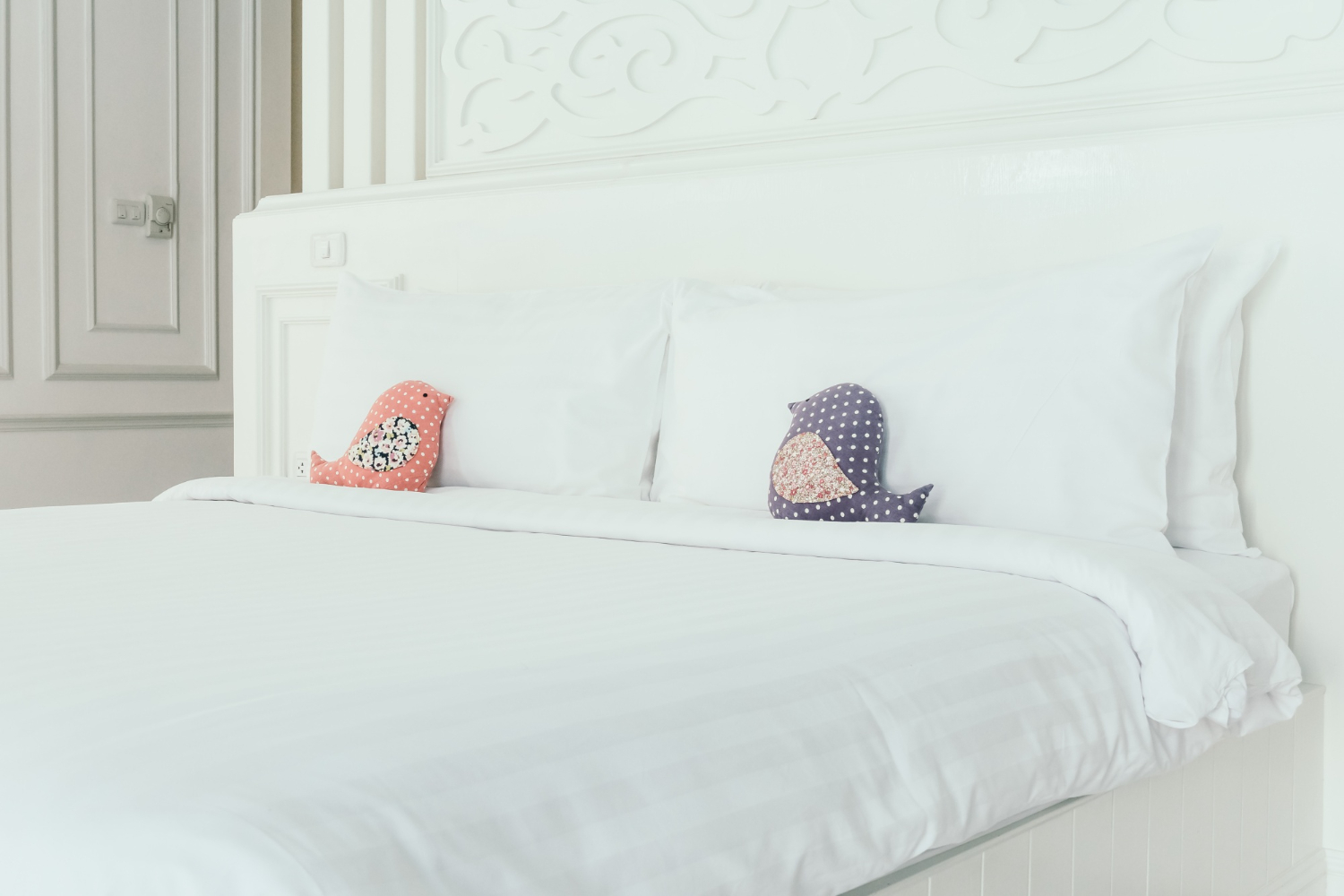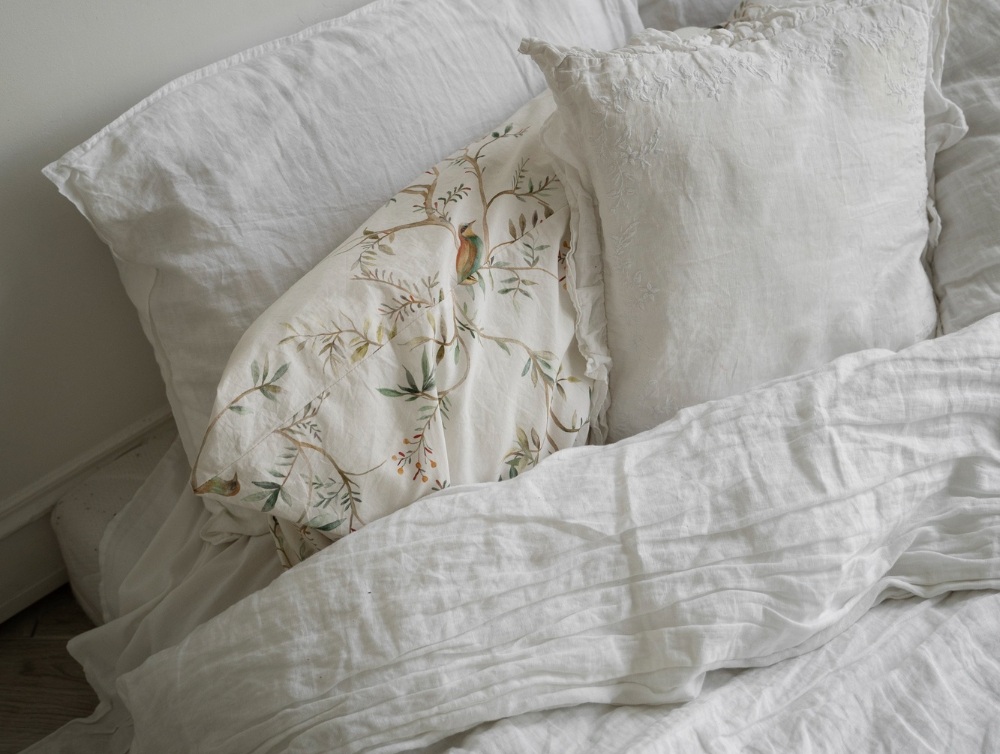
When someone in your household has an allergy or asthma condition, comforter care becomes even more important during certain seasons. Spring pollen, fall dust, and winter’s closed-up houses all contribute to worsening symptoms.
But even during regular days, allergens build up quietly in layers of fabric, unnoticed until the sneezing starts. What looks clean to the eye may not be healthy to breathe. Simply put, the effort you put into caring for your comforter pays off in healthier nights of rest.
Wash Comforters Every 1–2 Weeks During Allergy Seasons
Seasonal changes can make life harder for anyone with asthma or allergies. Spring pollen, summer humidity, and fall dust all settle deep into bedding, creating a hidden source of irritation at night. Washing your comforter every 1–2 weeks during these times prevents allergen buildup and helps maintain cleaner indoor air.
To make this routine more effective, here’s what you can do during high-risk months:
Washing Tips During Allergy Seasons
- Schedule washes on the calendar – Mark specific days every two weeks so it becomes part of your household routine.
- Pair with sheet changes – Whenever you strip the bed, check if your comforter is due for its allergy-season wash.
- Keep a backup comforter – Rotate between two, so you always have a fresh one ready while the other is being laundered.
Consistent laundering during allergy seasons is one of the simplest ways to reduce flare-ups and keep your family breathing easier.
Use Hot Water (130°F / 54°C or Higher) When Fabric Care Allows
Hot water is one of the most powerful tools against hidden allergens. At 130°F or higher, dust mites are killed, bacteria are neutralized, and embedded irritants are washed away. While cooler cycles freshen fabric, they don’t eliminate what actually triggers symptoms.
Hot Water Wash Guide
- Check the care label first – Not all fabrics can handle high temperatures without shrinking or clumping.
- Run an extra rinse cycle – Hot water loosens more debris, and an extra rinse helps carry it all away.
- Use dryer heat immediately after – Pairing hot water with a hot dryer cycle ensures allergens don’t survive.
When fabric care allows, high-temperature washing is one of the most reliable defenses against allergy triggers hidden in comforters.
Choose Fragrance-free, Hypoallergenic Detergents
Detergent choices often make the difference between bedding that’s comfortable and bedding that irritates. Many popular products contain perfumes, dyes, or enzyme blends that can aggravate sensitive skin and airways. Switching to fragrance-free, hypoallergenic formulas keeps your clean comforter from becoming a new source of irritation.
Choosing the Right Detergent
- Stick with “free and clear” labels – These avoid artificial scents that linger on fabric.
- Look for dermatologist-tested brands – They’re designed to reduce skin irritation.
- Choose liquid over powder – Liquids dissolve more fully, leaving behind less residue.
By making this small change, you’ll not only wash away allergens but also prevent new irritants from clinging to your bedding.
Always Rinse Twice to Remove Detergent Residue
Even with mild detergent, residue often lingers in the thick layers of a comforter. Soap particles cling to fibers, attracting dust and pollen while irritating sensitive skin. Adding a second rinse is an easy safeguard that ensures your comforter is as clean as it feels.
Effective Double Rinsing
- Use your machine’s “extra rinse” setting – Most modern washers include it as a standard option.
- Check water clarity – If suds remain during the first rinse, run a second rinse cycle until the water runs clean.
- Rinse with warm water – Warmth helps release any detergent clinging to dense fabric layers.
This one extra step takes only a few minutes but pays off in fresher comforters and fewer allergy irritants.
Thoroughly Dry Comforters – Preferably in Direct Sunlight or a Hot Dryer
A comforter that feels dry on the surface can still hide dangerous moisture deep inside. Dampness provides the perfect environment for mold, mildew, and odor-causing bacteria. Drying thoroughly, whether in direct sunlight or in a hot dryer, keeps bedding safe and fresh.
Proper Drying Tips
- Use a hot dryer cycle for durability – Heat penetrates deep layers and ensures allergens don’t survive.
- Air dry outdoors on sunny days – UV rays kill bacteria and leave fabrics naturally refreshed.
- Add clean tennis balls or wool dryer balls – They improve airflow, reduce clumping, and cut drying time.
A fully dry comforter isn’t just more comfortable; it also eliminates one of the biggest hidden risks for allergy sufferers.
Use a Comforter Cover or Allergy-proof Encasement
Protective covers act as a shield, blocking dust mites, pollen, and dander from penetrating your comforter. They make cleaning easier by keeping most allergens on the surface, where they can be washed away weekly. For families with allergies, this layer of defense is invaluable.
Cover Care Guidelines
- Choose tightly woven fabric – High-quality encasements prevent particles from slipping through.
- Wash weekly with your sheets – This quick routine keeps allergens from settling in.
- Invest in zippered designs – A snug closure keeps your comforter sealed off from contaminants.
With a protective encasement, your comforter stays cleaner for longer and requires fewer deep washes.
Avoid Fabric Softeners and Dryer Sheets
What feels like a luxury touch can actually create hidden risks. Fabric softeners and dryer sheets leave behind chemical residues that cling to fibers. For those with allergies or asthma, these residues can cause irritation and lock in allergens instead of rinsing them away.
Instead of relying on softeners, here are healthier alternatives:
- Switch to wool dryer balls – They naturally soften fabric and improve airflow.
- Use vinegar in the rinse cycle – It helps freshen fabric and reduces static without chemical buildup.
- Choose fragrance-free alternatives – Some specialty brands offer safe, non-irritating options.
Avoiding fabric softeners gives you softness and freshness without hidden allergens.
Shake and Fluff Comforters Daily
A quick morning habit can make a big difference for allergy control. Shaking and fluffing your comforter loosens surface dust, prevents clumping, and improves airflow. This simple step also keeps the fill evenly distributed, extending the life of your comforter.
Here’s how to make daily fluffing more effective:
- Do it in the morning – Shaking out dust after a night’s sleep prevents buildup.
- Take it outdoors when possible – A quick shake in fresh air releases more trapped particles.
- Smooth out seams and corners – Keeps the filling distributed and prevents flat spots.
Daily fluffing takes only seconds but keeps your bedding cleaner and more breathable.
Consider Professional Deep Cleaning for Bulky Comforters
Some comforters are simply too large or too delicate for a standard home washer. Down-filled or oversized bedding can trap allergens deep inside, even after multiple home cycles. A professional Comforter Cleaning Service uses industrial-strength equipment and fabric-safe methods to give these bulky pieces a thorough refresh.
Tips When Scheduling a Professional Comforter Cleaning Service
- Book once or twice a year – This keeps embedded allergens from building up over time.
- Choose a service with allergy-care options – Many offer hypoallergenic cleaning methods.
- Look for Pickup and Delivery Service – Makes the process more convenient for busy families.
When your comforter feels heavy, clumpy, or never quite clean after home washing, a professional Comforter Cleaning Service restores it to a healthier, fresher state.
Protect Your Family from Allergens – the Comforter Cleaning Service at Red Hanger Cleaners Delivers Freshness
For healthier sleep, start with cleaner comforters. At Red Hanger Cleaners, we specialize in cleaning comforters, duvets, and bedspreads made from different fills and materials. Our commercial-sized washers are designed for bulky bedding, while our professional detergents break down body oils and allergens regular machines simply can’t touch.
Aside from comforters, we also clean Blankets, Pillows, Cotton, Silk, and Satin Bedsheets, Afghans, and so much more.
Here’s how to get started:
Step 1: Create Your Account.
Step 2: Leave your bedding to us.
Step 3: Sleep your best.
Sign up online today, and we’ll start adding loyalty credits right away. We are Utah’s best and largest dry cleaner and professional laundry with locations throughout Utah, Salt Lake, Davis, and Weber counties.
